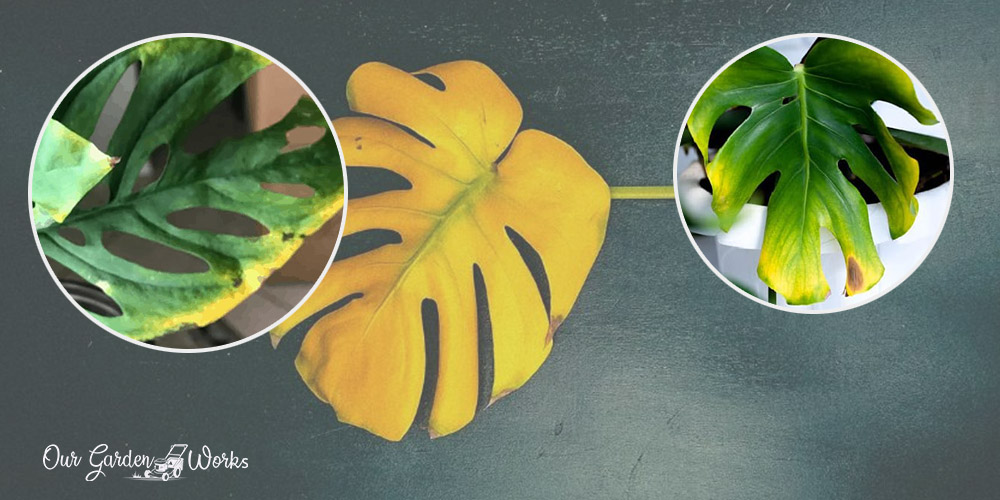The Swiss cheese plant, or monstera, is prized for its unique leaves. Just like other houseplants, the splits and fenestrations of Monstera are not immune to yellowing.
Swiss cheese plant yellowing leaves can be due to any of the following causes of plant stress:
- Watering issues.
- Low humidity.
- Improper light.
- Fungal infection.
Monstera is a genus of plants that thrives in humid and low-light areas. Their leaves need partial sun and minimal watering. So, yellowing patches or spots on the leaves signify something is not right in its growing environment.
(You could use the table of contents below to jump to the sections that are most important to you.)
Types of cheese plant yellowing leaves and what they mean
Professional gardeners with years of experience handling monstera have peculiar ways of recognizing the cause of the yellowing through yellowing patterns and a combination of signs. Check out the signs and becomes a wise plant parent for your monstera.
#1 Yellowing + brittle + droopy/curling leaves: Underwatering
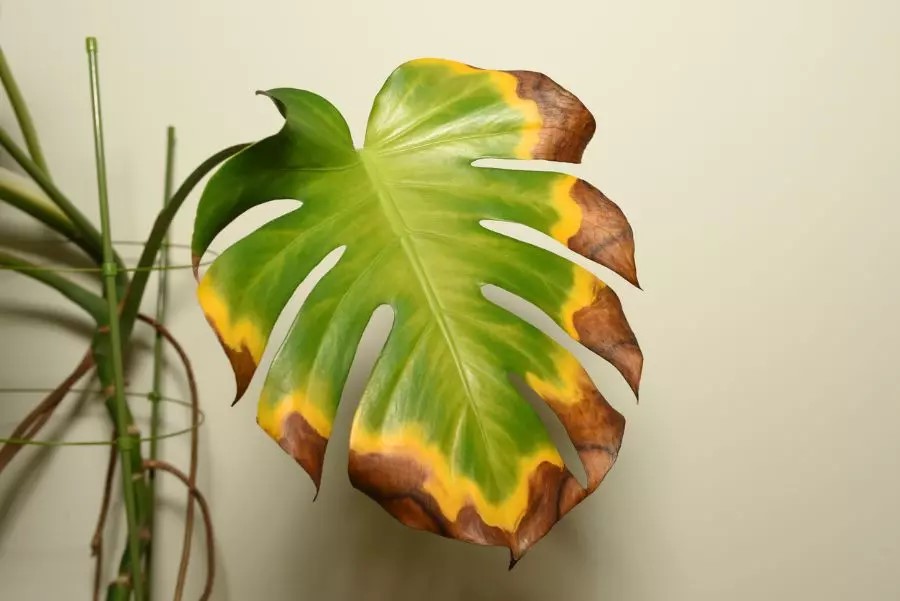
Houseplants like Monstera and Philodendron are not a fan of wet feet and drought stress. Their widely spread leaves needs sufficient moisture to maintain their glossy leaves.
Without adequate moisture, the leaves will initially droop, yellow, and turn brown and brittle.
Some gardeners water their plants lightly in fear of overwatering them. However, the water on the surface of the soil fails to reach the roots and makes the plant thirsty.
The good news is that an underwatered Swiss cheese plant is easier to treat than an overwatered one.
How to treat an underwatered Swiss cheese plant
Deeply water your Monstera by either letting the water pass through the drainage holes.
With extremely dehydrated monstera, you may place the plant under a running water in the sink and let the plant rehydrate as much as it can.
Monstera are dramatic plants and you’ll surely see how they change when their need are met after days of neglect.
The sign that it can survive extreme drought is when its droopy leaves start to perk up again. For some such changes happen within minutes but for severely dried ones, it may take days to see some good signs.
#2 Yellow leaves/stems + moist soil: Overwatering
Too much watering can kill any houseplant. Monstera are not designed for a wet soil environment since their roots can easily rot.
When there’s too much water in the soil, the roots will drown and fail to absorb nutrients in the soil.
The roots will also eventually rot which will further cause nutrient deficiency to the plant.
Without the basic nutrients and minerals, the plant will fail to maintain its leaves and other plant processes.
Aside from Swiss cheese plant yellowing leaves, here are other signs of overwatering:
- Soil not drying out for a week
- Mold on the soil.
- Foul smell.
- Droopy leaves with brown leaf spots.
Overwatering issues are usually caused by frequent watering but it can also be caused by three other factors. These include:
(1) Poor soil drainage: Potting mix intended for monstera should be light and composed of materials that promotes good drainage.
If there’s too much peat or the potting mix remain unchanged for three ways, then the soil must be retaining too much water than the roots ever need.
The decomposition of soil materials, like compost and bark chips, is the reason why potting mix needs to be changed or amended every two years.
(2) Pot drainage holes: Indoor Swiss cheese plants are usually placed in decorative pots that does not have any holes in them.
Oftentimes, these cases comes from plants sent by your friends as gifts. Ideally, you must use a smaller inner pot that you can place inside the no-hole decorative pot.
(3) Pot size: The pot size should correspond to the size of the plant. When the pot is too big for the plant, the roots will fail to completely absorb the moisture in the soil, leading to water stagnation and root rot.
How to treat an overwatered Swiss cheese plant
The stress of overwatering plants is more devastating than underwatering them.
When treated early, the plant may survive. However, when all of its roots rot, the plant may not survive.
Here are some steps on how you can start treating your drowning monstera:
- Remove the plant from the pot and inspect the coverage of the damage in the roots. Release the roots from the soil to see it better. Carefully pull the plant to avoid causing any wounds or severing any viable root.
- If the roots are mushy, then they are already rotten and must be removed. Prune the rotten roots with sanitized pruning shears.
- Prepare a new potting soil for your swiss cheese plant and apply fungicide to prevent the spread of the root rot. Ensure that the pot has enough holes and the potting mix contain chunky materials for optimal soil drainage.
Tips in watering Monstera, Philodendrons, and other houseplants
Novice gardeners would often follow directions they search on the internet or product labels when watering their plants.
However, the ability of the plant to absorb moisture depends on a lot of factors like changes in climate, humidity and their dormancy period.
Therefore, watering should be based on the actual behavior of the plant and the condition of the weather.
The simplest way to know when it’s time to water Monstera is when the soil is dry during a finger test.
The finger test is simply dipping your finger in the and manually identifying if it’s still moist or not.
- Water the soil if your fingers does not have any soil particles sticking to it.
- Delay watering when you visibly see the soil wet or there are some particles left on your finger.
#3 Yellow patches + yellowing along the leaf veins: Too much / Low light
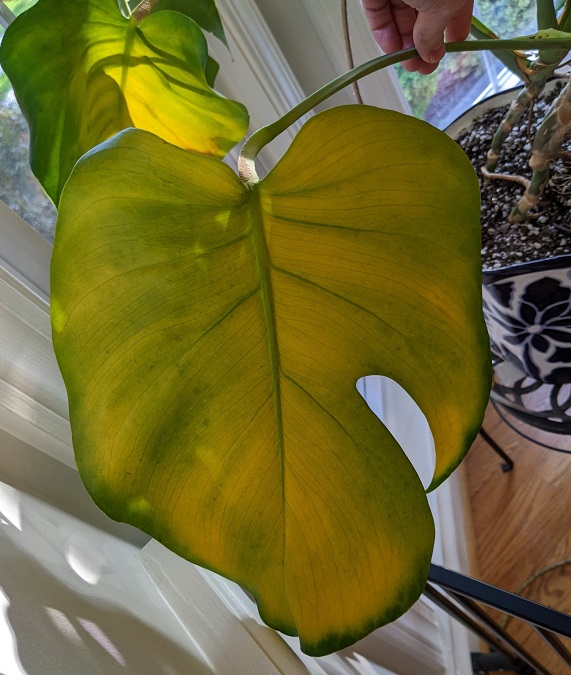
Swiss cheese plant or monstera is not a fan of the extremes like extreme light exposure. In its natural habitat, it thrives in the dappled sunlight under the trees.
Studies also suggest that its splits and fenestrations or holes are designed to allow the sunlight to pass through and reach the younger lower leaves.
Monstera leaves can be damaged with full sun, leading sunburns. On the other hand, the plant will not be able to perform its crucial plant processes, like photosynthesis, if it is not getting enough sunlight causing Swiss cheese plant yellowing leaves. Plants consider sunlight as an energy source and without it they will wilt and die.
Ideal light condition for Monstera
The best light conditions that must touch the leaves of Monstera is the bright indirect light from early morning and late afternoon sun.
You must protect it from the harsh afternoon sun and ensure that it is not placed in an area where direct light might land on its leaves.
In case your place does not receive ideal sunlight throughout the day like cramped urban spaces, or the weather is bad enough to provide sufficient sunlight, you may use grow lights.
The most ideal areas of the house for monstera are the:
- Bedroom (next to the windows).
- Living room (along pathways that receives indirect light).
- Dining room (light comes from the kitchen windows).
#4 Yellow leaves turning brown + brittle leaves: Humidity issues
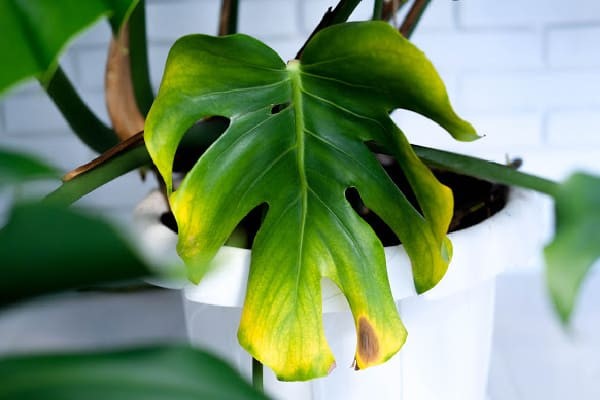
Humidity is big for Swiss cheese plants. They rely on 40% humidity and above to maintain the moisture on the leaves and stems.
However, as the temperature changes and the ventilation becomes limited, the humidity may drop which leads to drought stress showing as yellowing and drying leaves.
The temperature is relative to the humidity level since it dictates the amount of water vapor released in the air.
When the climate is warm, there is more water vapor in the air since it allows a faster evaporation. A cold climate, on the other hand, dries out the vapor in the air which causes dry air.
How to adjust the humidity levels indoors
Proper watering and optimal indoor humidity levels is the key for a healthy Swiss cheese plant.
With the help of a hygrometer, you may monitor the indoor humidity in your home to ensure that your houseplants are getting enough moisture in the air.
Here are some tips that you can try:
- Place the pot on top of a pebble tray.
- Move your monstera in the bathroom to receive the humidity produced when teh shower or faucet is on.
- Use a humidifier indoors.
- Place other houseplants around your sick plant.
- Mist the plant once a day or when the heater is on during winter.
#5 Yellow patches around the leaf: Fluctuating temperature
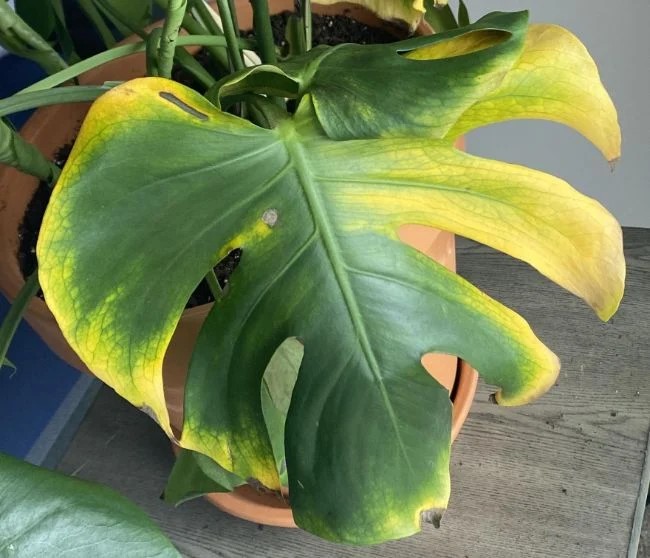
We all need consistency when it comes to our needs, even Swiss cheese plants. They need consistent levels of temperature to avoid environmental stress.
Sudden fluctuation in temperature shocks monstera plants which leads to yellowing and stunted growth.
Usually, temperature stress is caused by sudden changes due to the gush of wind from cold drafts in winter.
Sometimes, the turning on and off of heating and air conditioning appliances can also be a cause of temperature stress to houseplants. The ideal range of temperature for houseplants is 60℉ to 85℉.
How to prevent temperature stress on Swiss cheese plants
Sometimes, we often overlook the chance of temperature stress when we place our houseplants in well-lit areas.
Sadly, the yellow leaves will no longer turn green. However, you can prevent the other leaves from turning yellow by doing the following preventive steps:
- Don’t place your houseplants near drafty windows during winter.
- Keep your plants away from doors, air conditioning units, and heaters.
- Try to frequently turn on and off ventilation appliances like heaters and air conditioners.
#6 Yellowing tips + poor growth: Nutrient deficiency
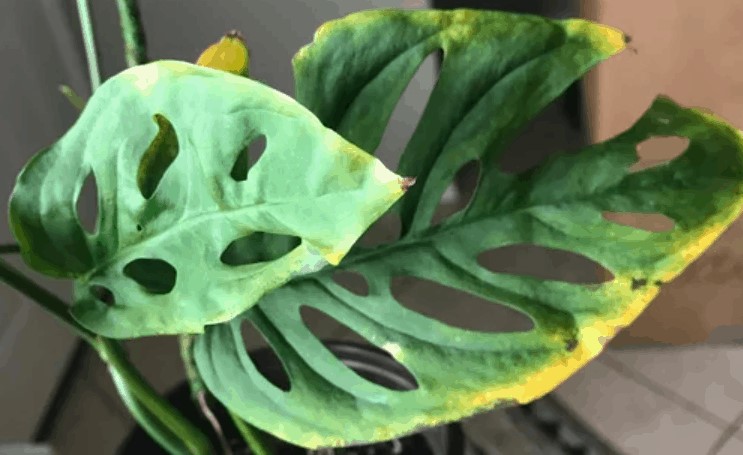
Monstera rarely needs fertilizers. It is one of their unique charms that makes them easy to grow and beginner-friendly.
The yellowing of its leaves is its way of telling gardeners that it needs nutrients through patterns like yellowing tips. Usually, the deficiency comes from low nitrogen and iron caused by:
- Unamended or unchanged potting soil.
- Overwatering.
- Infrequent feeding.
- Changes in soil acidity.
Best ways to fertilize Swiss cheese plants
Nutrients in the soil can deplete when the organic materials have decomposed or watering has leached it out of the soil. Another possible cause is soil pH level that doesn’t match the tolerable range of the roots of the plant.
Monstera plant species require a soil pH level of 5.5 to 7.0, which is slightly acidic. If the soil acidity is out of that range, then the roots can’t get the nutrients from the soil, leading to nutrient deficiency.
Here are some steps that you can try to ensure the optimal nutrient absorption of your monster:
(1) Replenish the organic materials in the potting mix every two years. These organic materials include but not limited to bark chips, compost, and peat moss.
(2) Use rainwater in catering your plants to improve acidity and increase the levels of minerals.
(3) Use ideal fertilizers for monstera, such as:
- Miracle-Gro Water Soluble All Purpose Plant Food.
- Burpee Natural Purpose Granular 4-Lb Organic Food.
- FoxFarm Happy Frog All-Purpose Fertilizer.
- Shake ‘N Feed All Purpose Continuous Release Plant Food.
You may also use diluted Epsom salt to add magnesium and sulfur to your monstera. However, make sure that they are deficient to it before application.
#7 Yellow leaves + wilting + unnatural holes: Pest infestation
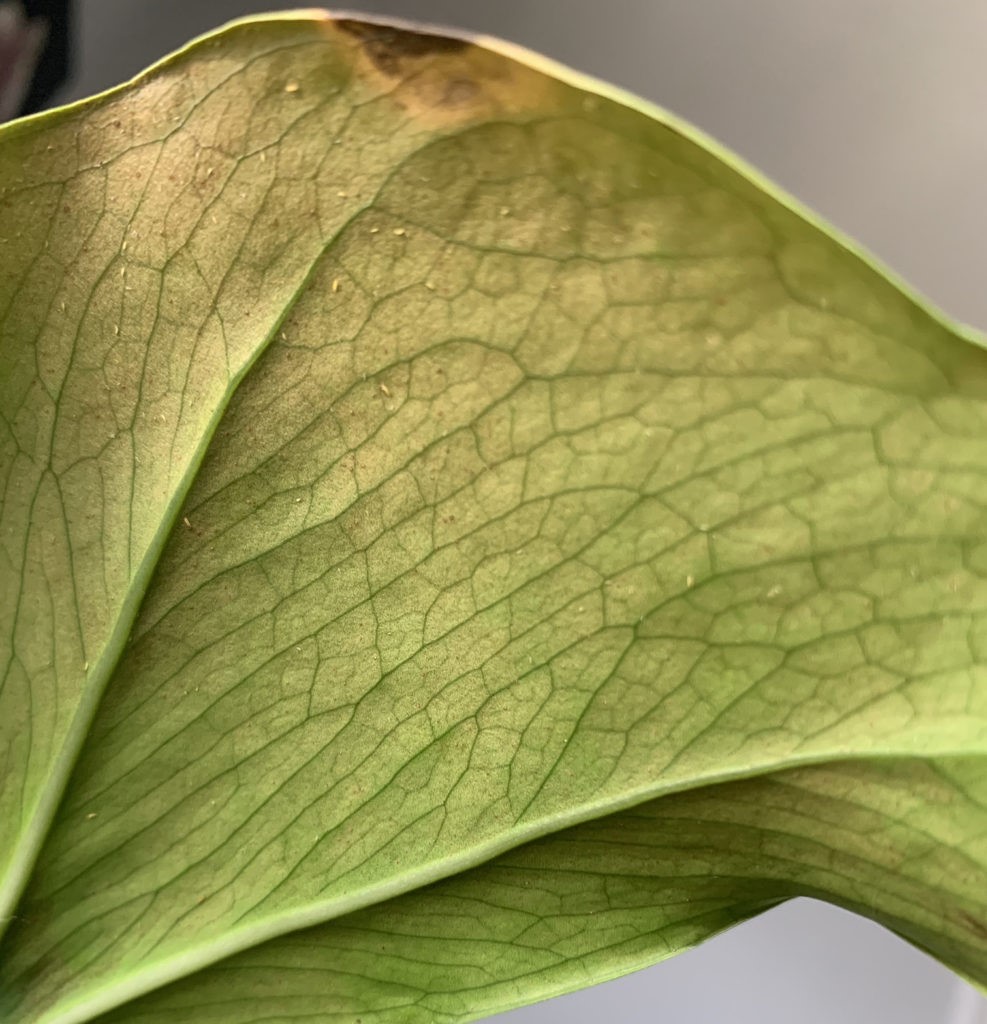
Sometimes the yellowing on the leaves comes from the lack of sap caused by sap-sucking insects.
Pests weaken plants that prevent growth and kill them eventually. The biggest indicator of pest infestation aside from the yellowing leaves are the unnatural holes found in some parts of the leaves.
Healthy monstera plants can naturally resist the stress caused by pests. However, with heavy infestations, pests can weaken the plant and cause some yellowing, bumps, or brown spots on the leaves. Common pests in monstera are as follows:
- Aphids.
- Scale.
- Mealybugs
- Whiteflies.
- Leafminers.
- Fungus gnats.
- Thrips.
- Scale.
Best pesticides for Monstera
With mild infestations, you may splash the leaves with water. However, if the pests persists in feeding on your poor monstera, you may use the following pesticides:
#8 Yellow patches + soil drying out fast: Rootbound
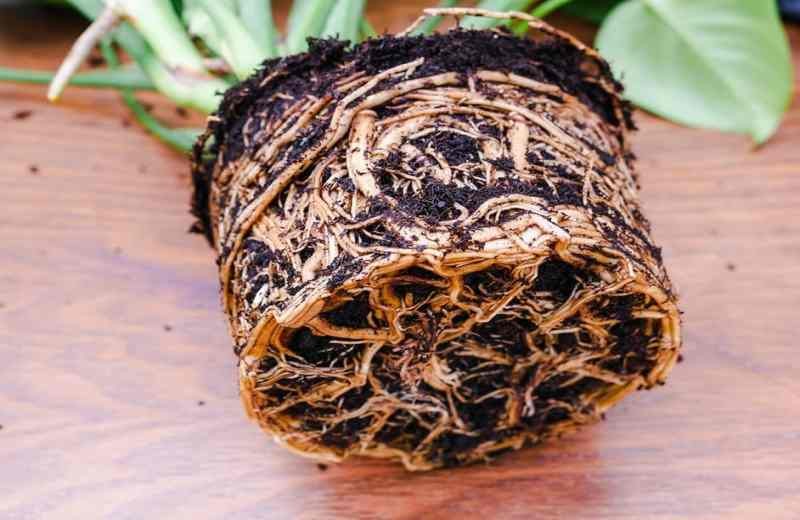
If you’ve done all the right steps in watering fertilizing and protection against pests and temperature stress, then probably, your monstera has outgrown its pot.
Rootbound is a condition where an old monstera plant is choking itself due to excessive growth of roots.
Leaving your monstera in rootbound state can weaken the plant due to lack of nutrients and make them more susceptible to root rot.
Here are some signs that your plant might be root bound:
- Water drains too fast or pools on top of the soil.
- The roots are showing on the surface of the soil or around the pots.
- It’s hard to remove the plant from the pot due to excessive roots that clings to the pot.
How to manage a rootbound monstera
A root bound monstera needs to be repotted in a larger pot. Some gardeners prefer to no longer untangle the thick roots.
However, you may also prune the excess roots to loosen the chokehold of large roots. During the process, you may also check if you can get a cutting that you can use to propagate.
Final Thoughts
Monstera and other houseplants are easy to grow but can be sick from time to time.
If you don’t have a keen eye in observing the yellowing patterns on the leaves, then you have to do an elimination process and check each aspect of care one by one.
If you still fail to identify the problem, then it’s possible that the yellowing leaves have seen better days and ready to die so new leaves can emerge.
Let us know in the comments which plant problem resonated to you the most. Also, please share this post to your friends and help figure out the problem of their monstera plants.
